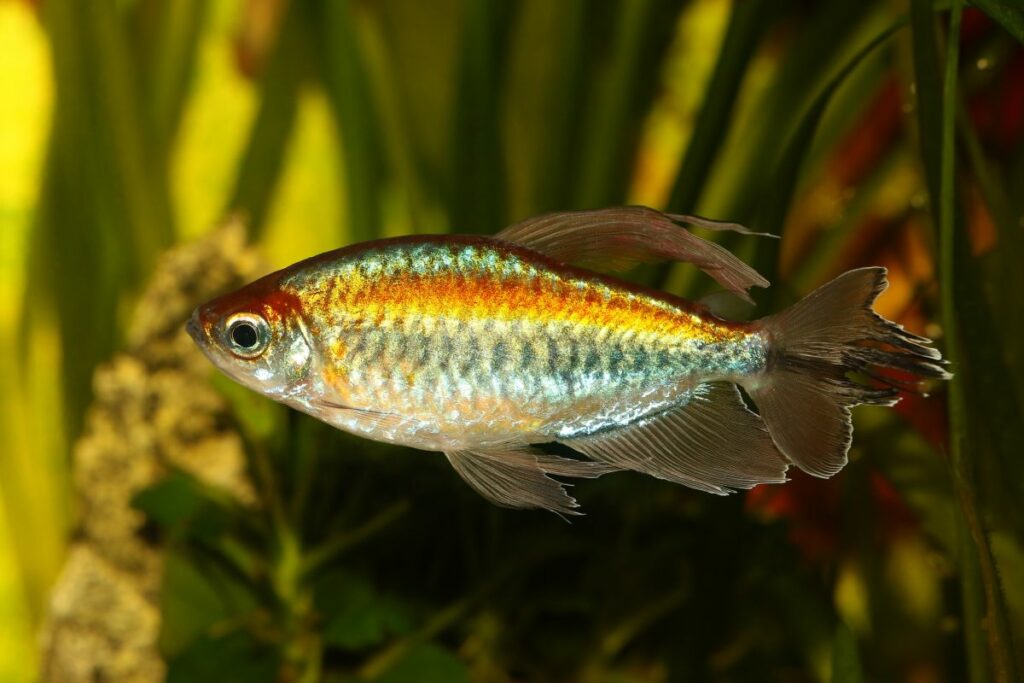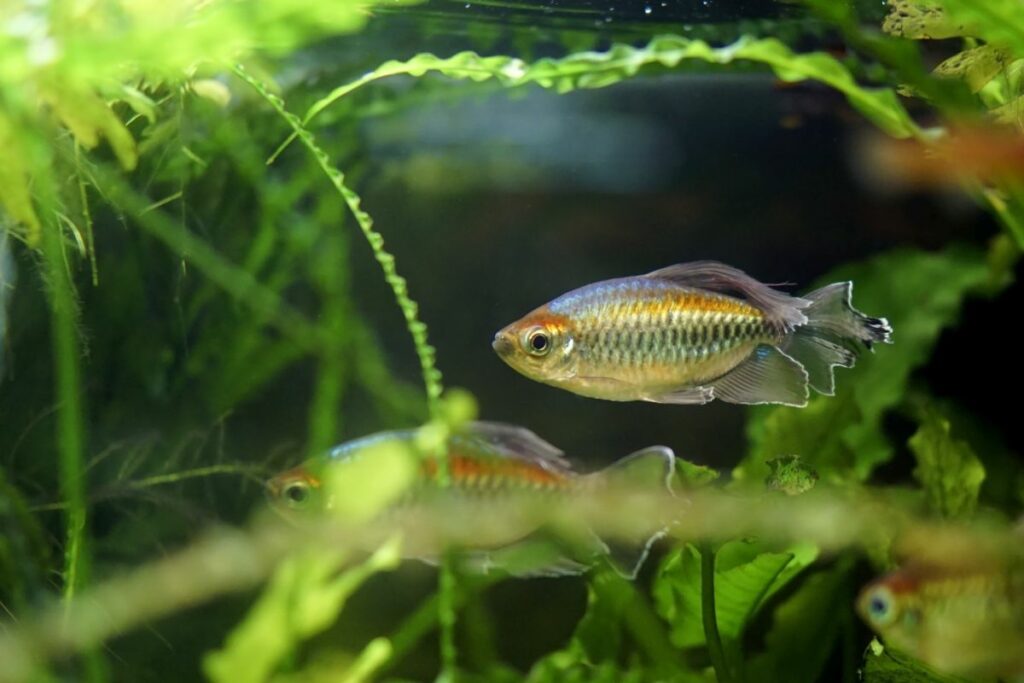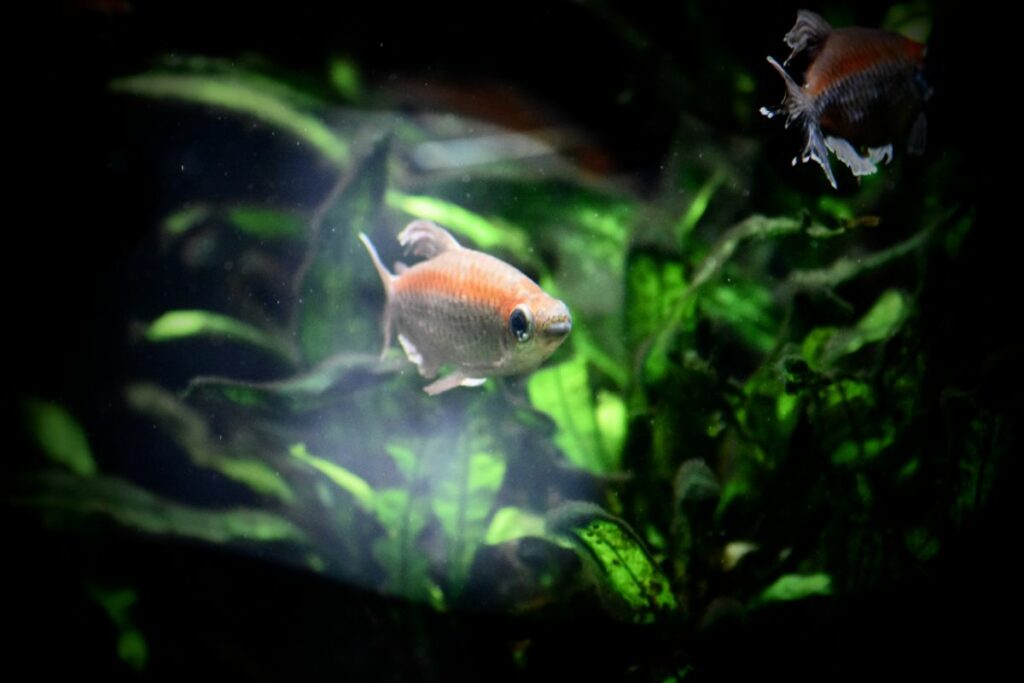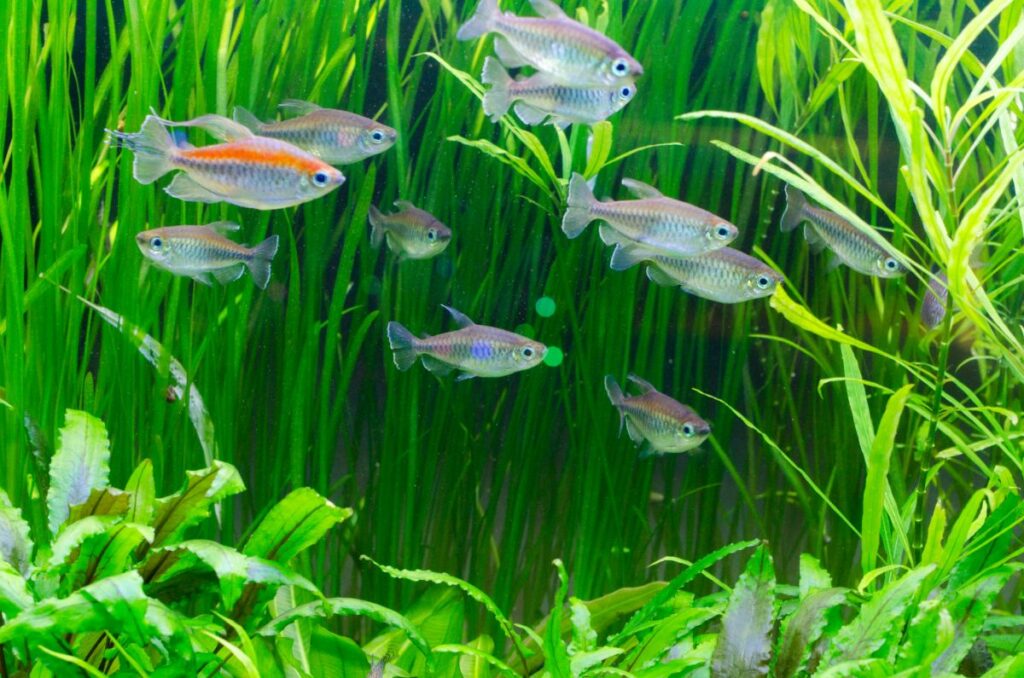The Congo Tetra is a small, beautiful fish species that lives in freshwater. They’re great for fish keepers of all experience levels, but any fish can be tricky to care for if you’ve never had an aquarium before.
So, here’s everything you need to know if you want to care for some Congo tetras.

Congo Tetra Overview
Before we dive into the details of this shiny fish species, let’s look at an overview so you can know what to expect.
| Family | Alestidae |
| Origin | Congo River Basin |
| Lifespan | 3 to 5 years |
| Temperament | Peaceful |
| Size | 2.5 to 3.5 inches |
| Minimum Tank Size | 30 gallons |
| Diet | Omnivore |
| Breeding | Egg layer |
| pH | 6.0 to 7.5 |
| Hardness | 3 to 18 dGH |
| Temperature | 72 to 82 Fahrenheit |
| Beginner-Friendly? | Yes |
Congo Tetra Fish History
While many people keep these fish as pets, they can also be found in the wild in the Congo River Basin of Africa. They prefer to stay in water that’s warm, murky, and slightly acidic. You’ll likely find them hidden among tall vegetation.
The species wasn’t discovered until 1949. Then, it wasn’t popular in captivity until the 1960s and 1970s. Over time, these fish became even more common in aquariums for keepers of all experience levels.
Appearance
Congo tetras are beloved because of their colorful scales that shimmer. They have long, flat bodies with semi-transparent fins.
Full-grown fish have iridescent scales, which have a gray/blue color on the top and bottom, but an orange/gold color in the middle.
The shiny scales are mesmerizing to watch as the fish swim around. The colors they appear as depend on how light reflects off their bodies.

Congo Tetra Male vs Female
Males and females look similar, but males are slightly larger. However, the females are a bit rounder, especially when they’re getting ready to breed.
Males also tend to be more colorful than females. The fins on a male have a purple tint to them, and the male’s tail fin is longer. Otherwise, all other characteristics seem to be the same.
Congo Tetra Size
Most Congo tetras in captivity grow between 3 and 3.5 inches long. However, females will sometimes be a little smaller at 2.5 inches. In the wild, these fish are known for growing larger than in captivity, reaching up to 4.5 inches.
Congo Tetra Behavior
Most of these fish are very peaceful. If they’re near an aggressive fish, they’re more likely to swim away than fight back.
They may spend a lot of time hiding if something is making them nervous. They’re the least stressed when kept with other fish of the same species.
When swimming, Congo tetra fish stay toward the top or middle of the tank. Sometimes, they will nibble at plants in the tank as they swim, but that’s just a sign that they’re not being fed enough.

Congo Tetra Tank Mates
The best tank mate for a Congo tetra is other fish of the same species. They’ll often swim around the tank in groups, so they’ll stay more active and less fearful.
One of these fish should be kept with at least five others of its kind.
If you want to introduce other species to the tank, look for calm fish that are a similar size. If you buy fish that are aggressive, they may harass your Congo tetras and nip at their fins. So, be cautious of what animals you introduce to the tank.
Here are a few species that can be kept with the Congo tetra:
- Neon tetras
- Corydoras
- Mollies
- Rainbowfish
- Ember tetras
Congo Tetra Care Requirements
These fish are fairly easy to care for as long as you give them a proper environment to live in.
That means ensuring that the aquarium is the right size with the correct water conditions and food.
Here’s how to ensure that your fish receive the best care.
Congo Tetra Tank Size
When it comes to choosing an aquarium for any fish, it’s always a good idea to make it bigger than necessary.
Some tetras may be able to survive in a 20-gallon tank, but a good fish keeper will ensure that the tank is at least 30 gallons so the fish has plenty of space to explore.
The more fish you want to keep in the tank, the larger it will need to be. A bigger tank also means more room for plants and decorations, so fill it with as many places for your fish to hide and explore as possible.
Congo tetras love having clumps of plants to hide in if needed. However, they also like to have enough open space in the tank to group up while swimming.
You’ll also want to have artificial caves for them to hide in and a filter to keep the tank clean. Set up everything in the tank before bringing home the fish.
Water Conditions
The key to reducing a fish’s stress is to mimic their natural environment as much as possible. In the wild, they live in warm waters in the Congo River Basin.
So, the water in their aquarium should be between 72 and 82 degrees Fahrenheit.
Then, make sure the water’s hardness is between 3 and 18 dGH, and the pH levels should be between 6.0 and 7.5. Luckily, these parameters are a wide range because Congo tetras aren’t picky. So, it shouldn’t be difficult to keep the water to their liking.
On occasion, you can check the water’s conditions using water test strips. Then, you can ensure that your fish will thrive in their environment.

Food
Luckily, these fish will eat just about anything they’re given. In the wild, they’re omnivores, so they’ll consume both plants and animals. Insect larvae, algae, and plants are just a few things these fish might feed on in the wild.
Most pellets and flakes will work just fine for these fish. To add to their diet, you can also give them nutrient-rich treats once in a while. Some snacks they might enjoy include brine shrimp, bloodworms, and daphnia. Small vegetable pieces could also be beneficial for them.
Some Congo tetras are shy when eating, so you don’t have to watch them eat. If you’re worried your fish aren’t eating enough of the food, you can try putting the food in a feeding ring to make it easier for them to access.
Common Diseases to Watch Out for
Congo tetras are susceptible to the same diseases as any other fish. They don’t have any breed-specific issues.
Ich is the most common issue that fish face. It occurs when fish become overly stressed, and it appears as white spots across their body.
Luckily, treatment options are available, but it can be prevented by giving your fish a proper environment to reduce their risk of stress.
In fact, using proper water parameters and keeping up with tank maintenance are great ways to avoid any potential health problems. Preventing disease in fish is much easier than trying to find a treatment method.
Congo Tetra Breeding
If you’re interested in breeding your Congo tetras, it’s fairly easy! When breeding, the fish lay up to 500 eggs at once, so you will have your hands full.
Breeding these fish can occur in a 20-gallon tank with peat boss at the bottom. Let the tank cycle for a few days before adding a bonded male and female pair into the tank.
Get the water temperature to about 77 degrees Fahrenheit and turn off all lights near the breeding tank to begin the process.
Turn the lights on after a day, and then, the female will likely lay eggs in the moss after the mating process. You’ll know the fish are about to breed if the male fish performs a mating dance.
Congo tetras may try to eat their eggs, so the moss provides a layer of protection. However, once the eggs are produced, you can remove the adult fish from the tank and put them back into the regular aquarium.The eggs usually hatch within eight days of spawning.
Keep the young fish in the breeding aquarium until they become big enough to be able to eat fish food. Most fish will become big enough to need a full-size tank at about three months old. At three months, you may be able to tell their sex, but cannot breed until they reach about six months old.
Frequently Asked Questions
Before you bring home some of these fish, it’s important to have all your questions answered. So, here are a few things that new fish keepers commonly wonder.
Yes, these fish have teeth. Congo tetra teeth are tiny and sharp, but since they’re such docile fish, it’s unlikely that they’ll nip at other animals in the tank. Their teeth size will vary based on what their parents’ teeth look like.
Pet stores, breeders, and exotic pet rescues may all have Congo tetras for sale. When looking for a place to get your fish from, be patient and look for a reputable source. Find someone that prioritizes the health of the fish to ensure that you’ll be receiving fish in good shape. Never take a Congo tetra out of the wild.
Are Congo Tetras Right for You?
If you’re looking for an easy, beautiful fish to care for, then a Congo tetra might be right for you.
They have broad tank requirements and are peaceful, healthy fish. As long as you have enough space for their tank, you can consider owning some.
However, fish can be a bigger responsibility than many people realize.
So, make sure you have enough time and money to commit to their supplies and care before deciding to bring them home. Setting up an aquarium is a lot of work, but it’s worth it to keep your fish healthy and content.

